Echinocereus triglochidiatus is found growing various habitats of the Mojave Desert, in the states of NV, UT, CO, CA, AZ, and TX also into northern Mexico. Look for it on rocky slopes, hill country scrub lands, open forest lands, rocky outcroppings and cliff faces.
This species is comprised of a complex group of local populations. In this variable species the appearances of these populations differ markedly. There are many designated forms and varieties, however at this point they are not all are universally recognized. It is in my opinion best to use the collection location (if known)to differentiate between the differant forms.
Echinocereus triglochidiatus grow as upright mounding groups of cylindrical stems. From a few to hundreds of clumping stems. Stems are usually dark green and can be up six inches across. In White Sands, New Mexico they can stand up to thirty inches tall but across most of their range 12-24 inches is more of an average. The ribs can vary from as few as 5 to as many as 12.
Spine shapes, thickness, count, length and color vary widely. 3-11 spines per areole straight to curved or twisted. White to yellow, or gray to almost black. Angular in cross section to oval.
The flowers are tubular long lasting, dark scarlet to bright orange red with a thick waxy look. The flowers are pollinated by hummingbirds but I have also seen many a bee dive in to retrieve some pollen. I have never seen the hummers at the flowers. By the time they bloom for me (mid to late June) the hummingbirds are in the mountains feeding. They don't like the summer heat.
Good drainage, full sun exposure and regular deep soakings once every week or two produce healthy actively growing clumps. Chilly sunny winters to promote blossoms. They grow in areas that receave monsoon rains in the summer so like an intermittent soaking through the summer. Hardiness varies from highs of about 20 F (-6 C) to 0 F> (-17> C) depending on the population. I have heard they can take colder temps but have not grown them any colder.
They are touchy about being moved once established and if you have to move them, (bite the bullet) leave them out of the ground in the shade for a minimum of two weeks before you replant them. They rot easily if the wounds inflicted by the move have not callused over properly. When you can't stand to see them out of the ground anylonger and must replant them or go insane, (bite the bullet again) do not water them for at least two weeks.
http://www.efloras.org/florataxon.aspx?flora_id=1&taxon_id=242415252
http://www.swcoloradowildflowers.com/Pink%20Enlarged%20Photo%20Pages/ech...
The following shots are of mature plants growing in the garden of Charles Barnum , a friend who also lives and gardens in Sparks, NV. you should be able to see some of the variation in growth and appearance I mentioned.
Comments
Re: Echinocereus triglochidiatus complex
I second that, Mark, the last one takes the prize! It seems to be a special kind of red and set against the green, not so very spiny compared to the other two, body of the plant it looks fantastic!
Re: Echinocereus triglochidiatus complex
I'm glad you like them they are stunning to see in bloom on a sunny summer day.
Here are closer shots of the forms with heavy gray spines. These were collected in the mountains of north central New Mexico
The last one has a female Black-chinned Hummingbird (Archilochus alexandri) feeding.
Re: Echinocereus triglochidiatus complex
Truly awesome color, and I never would have guessed all those variations would be the same species, if the flowers didn't give me a clue first.
Re: Echinocereus triglochidiatus complex
Yes, a very fascinating color and the spiniest are are as good as the (almost) spineless! Are hummingbirds important pollinators for these plants?
Re: Echinocereus triglochidiatus complex
Hoy
Yes hummingbirds are a key pollinator in their native habitat. I have seen bees work on the flowers also but the flowers are adapted to favor the hummingbirds.
Re: Echinocereus triglochidiatus complex
Typical E. coccineus and E. triglochidiatus both usually have scarlet flowers, but in the southern reaches of their range often hybridize with E. dasyacanthus, and then you get an amazing range of taxa that have been classed as E. x roetteri or E. x lloydii depending on your taste.
I am attaching a picture of a pale pink x lloydii and one of the biggest clumps of coccineus I have encountered next to my nervous girlfriend near Moab a few years ago. Went back to the same clump this past spring and it was still gorgeous...
I have quite a few pix of other claret cup forms on my Picasa album: http://picasaweb.google.com/panayoti.kelaidis/CactusAndNAmericanSucculents#
Re: Echinocereus triglochidiatus complex
Hoy
Yes hummingbirds are a key pollinator in their native habitat. I have seen bees work on the flowers also but the flowers are adapted to favor the hummingbirds.
Thanks John! not unexpected!
Typical E. coccineus and E. triglochidiatus both usually have scarlet flowers, but in the southern reaches of their range often hybridize with E. dasyacanthus, and then you get an amazing range of taxa that have been classed as E. x roetteri or E. x lloydii depending on your taste.
I am attaching a picture of a pale pink x lloydii and one of the biggest clumps of coccineus I have encountered next to my nervous girlfriend near Moab a few years ago. Went back to the same clump this past spring and it was still gorgeous...
I have quite a few pix of other claret cup forms on my Picasa album: http://picasaweb.google.com/panayoti.kelaidis/CactusAndNAmericanSucculents#
You have an impressive album, Kelaidis, I would love to grow more cacti and other succulents but the space indoors and the climate outdoors set limits!
It's two nice motifs in your last picture but the vote goes to. . . .
Re: Echinocereus triglochidiatus complex
PK that is a nice clump of E. coccineus. ;D
Please correct me if I am wrong but some of the main differences between E. coccineus and E. triglochidiatus is the chromosome count and the imperfect (dioecious) flowers found in some populations of E. coccineus.
http://www.fs.fed.us/rm/pubs/rmrs_p036/rmrs_p036_438_443.pdf
Here is an article that covers the hybridization involved in creating E. x lloydii.
http://www.springerlink.com/content/W26882T152152355/fulltext.pdf
And here are a few pictures of my E. x lloydii.
Re: Echinocereus triglochidiatus complex
Wondeful color on your x lloydii! Do you ever get seed? It would be really interesting to grow seed out of that and see what the next generation would yield...
In my experience, E. coccineus blooms several weeks before E. triglochidiatus where their ranges overlap (or in the garden) and coccineus makes much denser, bigger clumps and is generally much spinier. And its flowers often have more orange in them. E. triglochidiatus also tends to have fewer spines, and much bigger ones and often has enormous stems (up to nearly 3' in the famous White Sands form) and the stems are often a dark bluegreen color. The flower color is usually a crimson rather than scarlet in flower color (all these are generalizations, I know)...but based on seeing hundreds of plants over time in gardens and the wild. They are all wonderful!
Re: Echinocereus triglochidiatus complex
PK it didn't set fruit this year. :-[ I hope it may this coming season. I think it was just too cold and the pollinators were not active. I will get my paint brushes out of storage and try my hand at pollinating it should the need arise.
Re: Echinocereus triglochidiatus complex
The color of E. lloydii wasn't bad either! What an ardent glorious flower!
Re: Echinocereus triglochidiatus complex
Echinocereus triglochidiatus var. mojavensis is one of the recognized varieties. It grows as a dense mound of stems with white interlacing spines and rich red flowers. The plants pup new heads readily and can in cultivation double the head count in a single season. The stems are not as large as found in other forms of Echinocereus triglochidiatus but the shear mass of large 500 head clumps in bloom is a sight to see.
Here are two pictures of 200< head clumps from the garden of Charles Barnum, Sparks NV.
The close ups are of a start he gave me. It was photographed in it's second season in my garden.
You can see how it has increased in size in just two years.
Re: Echinocereus triglochidiatus complex
Not a bad start, John!
Re: Echinocereus triglochidiatus complex
Add New Mexico to the states where this species grows. it can be found up to 8000 feet or so.
Re: Echinocereus triglochidiatus complex
Great plants, love the orange x lloydii..
Some high elevation populations are supposed to be very hardy, far lower than -17C.. I have a few seedlings I will be trying, but I think my problem with the Echinocereus in general will be a not hot enough summer...
Re: Echinocereus triglochidiatus complex
Here are a few shots of a Echinocereus coccineus I have had for six years now. Last year it had three or four flowers. This is it's second season of flowers. If it keeps increasing it,s flower production it will be spectacular in a couple of more seasons.
It looks like this one may be fully fertile.
Re: Echinocereus triglochidiatus complex
Here are a few shots of a Echinocereus coccineus I have had for six years now. Last year it had three or four flowers. This is it's second season of flowers. If it keeps increasing it,s flower production it will be spectacular in a couple of more seasons.
It looks like this one may be fully fertile.
John, I think it is spectacular now! Any chance for seed if it is fertile?
Re: Echinocereus triglochidiatus complex
It's going to take a bucket of water to put those out. The brighter the better. 8)
Re: Echinocereus triglochidiatus complex
Well I guess now I don't feel so bad that mine hasn't bloomed yet after seven years. (It is way smaller, too.) But oh my, look what I might have to look forward to!
Really cool 8) -I mean hot- John!
Re: Echinocereus triglochidiatus complex
Greetings,
Excellent photos and information. I'm currently growing this species from seed I got from Alplains collected in Chaffee County, Colorado at 7600ft (zone 4). I'm going to experiment with winter hardiness here in Western Montana (also zone 4). Has anyone seen this beauty? http://www.swcoloradowildflowers.com/pink%20enlarged%20photo%20pages/echinocereus%20triglochidiatus%202.htm. Or how about this one? http://www.swcoloradowildflowers.com/pink%20enlarged%20photo%20pages/echinocereus%20triglochidiatus%204.htm.
Brian
Re: Echinocereus triglochidiatus complex
Greetings,
Excellent photos and information. I'm currently growing this species from seed I got from Alplains collected in Chaffee County, Colorado at 7600ft (zone 4). I'm going to experiment with winter hardiness here in Western Montana (also zone 4). Has anyone seen this beauty? http://www.swcoloradowildflowers.com/pink%20enlarged%20photo%20pages/echinocereus%20triglochidiatus%202.htm. Or how about this one? http://www.swcoloradowildflowers.com/pink%20enlarged%20photo%20pages/echinocereus%20triglochidiatus%204.htm.
Those are some good looking cactus, I hope the do good for you.Brian
Re: Echinocereus triglochidiatus complex
My seedlings of Echocereus triglochidiatus from NARGS Seed Ex seed. So far, they have only overwintered in the refrigerator.
Re: Echinocereus triglochidiatus complex
My seedlings of Echocereus triglochidiatus from NARGS Seed Ex seed. So far, they have only overwintered in the refrigerator.
Coming along nicely.
Re: Echinocereus triglochidiatus complex
Here are a few shots of a Echinocereus coccineus I have had for six years now. Last year it had three or four flowers. This is it's second season of flowers. If it keeps increasing it,s flower production it will be spectacular in a couple of more seasons.
It looks like this one may be fully fertile.
Awesome! I think I would retire from gardening if I ever got a claret cup display like that.
Re: Echinocereus triglochidiatus complex
Thought I'd show off a hybrid Echinocereus x lloydii (syn. Echinocereus X roetteri), the natural interspecific hybrid between E. coccineus and E. dasyacanthus or E. triglochidiatus and E. pectinatus. I'm not quite sure which it correct. Although I think in this case I see more of a resemblance to E. dasyacantha. Do any of you know for sure which cross is correct for these hybrids or are there two separate hybrids which are listed under this name/ names? Very confusing I'm just glad the plants are not confused too and are able to produce lovely blossoms despite the confusion.
Re: Echinocereus triglochidiatus complex
Thought I'd show off a hybrid Echinocereus x lloydii (syn. Echinocereus X roetteri), the natural interspecific hybrid between E. coccineus and E. dasyacanthus or E. triglochidiatus and E. pectinatus. I'm not quite sure which it correct. Although I think in this case I see more of a resemblance to E. dasyacantha. Do any of you know for sure which cross is correct for these hybrids or are there two separate hybrids which are listed under this name/ names? Very confusing I'm just glad the plants are not confused too and are able to produce lovely blossoms despite the confusion.
From what I understand (I may be wrong) is that x roetteri refers to wild hybrids of E. coccineus and E. dasyacantha in New Mexico like around Orogrande where it is common. x lloydii is also a wild hybrid of coccineus/dasyacantha but from an area of Texas with different coccineus forms than New Mexico yielding a different looking hybrid than x roetteri. Like you say the bottom line is the plants are awesome no matter the name.
Re: Echinocereus triglochidiatus complex
Thank you Andy for the insight.
Re: Echinocereus triglochidiatus complex
Fantastic, John! :)
Brian, I also have a couple of the high altitude Alplains collections and will be trying more-- just seedlings so far... I think all the Echinos will be marginal here, in part because of coolish summers, I wouldn't think you should have too much trouble in the right planting in balmy z4 ;D
Re: Echinocereus triglochidiatus complex
A shining plant though, anyway ;)
Re: Echinocereus triglochidiatus complex
Trond, you can grow them all in an unheated greenhouse in Norway.
Re: Echinocereus triglochidiatus complex
Martin, I only have to get hold of them!
Har forresten sendt deg noen Sedum i dag ;)
Re: Echinocereus triglochidiatus complex
My very first claret cup flower just opened, only took 6 years to get one. I do quality over quantity here ;D
[attachment=1]
Echinocereus mojavensis
Re: Echinocereus triglochidiatus complex
Wow! And that is definite quality! :) Love the colour.
Re: Echinocereus triglochidiatus complex
Wow! And that is definite quality! :) Love the colour.
Ditto! For a first flower, it really has fantastic color and petal count, too. ;D

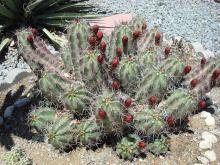
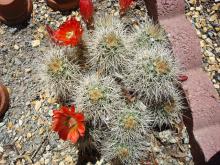
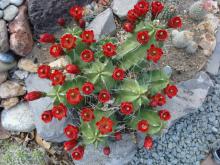
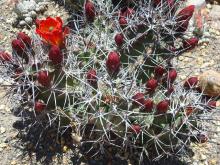
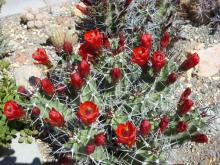
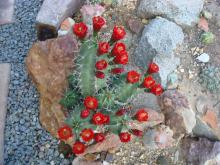
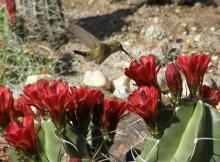
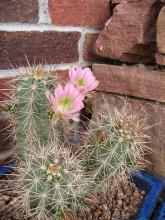
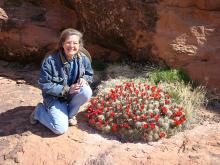
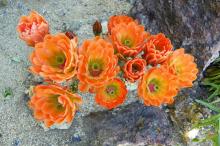
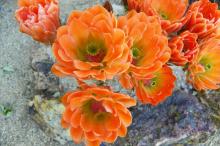
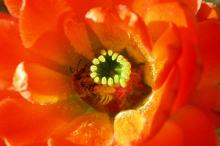
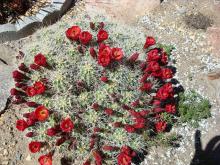
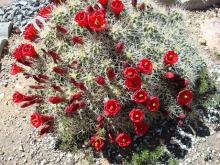
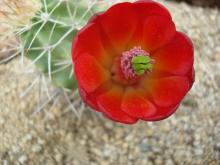
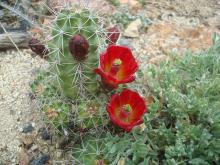
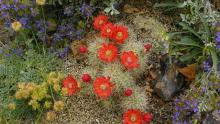
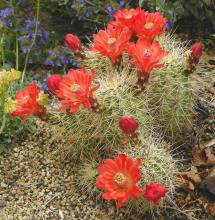
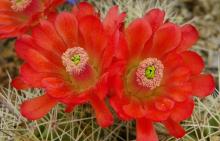
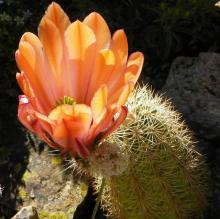

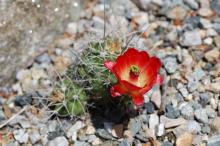
Fantastic variation in spination (is that a word?), I like them all, but the last one is spectacular.